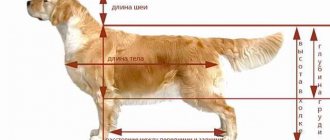When to worry
First of all, you need to figure out what the normal temperature should be, and in what cases you need to sound the alarm.
Norm for an animal
Temperatures within +37…+39 °C are considered normal for dogs. But these figures are average. They largely depend on the age, body weight and breed of the pet.
For example, ornamental breeds are characterized by high temperatures, reaching +39.3 °C. For large dogs, values not exceeding +38.3 °C are considered normal.
When measuring a puppy’s temperature, you need to take into account that for babies, an upward deviation of 0.5 degrees is permissible.
Fever
Changes in thermometer readings up to +39.5…+40 °C should cause concern. Temperatures above +41 °C are considered especially dangerous.
Temperature - what indicators should dogs have?
By measuring a dog's body temperature, you can determine its current condition. Its indicators can tell a lot. It should be noted that if the pet is not feeling well, the dog breeder will have to take drastic measures to take the necessary measurements and find out what is wrong with him.
Attention! The average body temperature of an adult dog is about 37.5-39°C. Any other indicators can be safely taken as a manifestation of any disease. Please note that fever can be caused by stress or shock. Also, a high temperature is the first sign of serious food poisoning.
If your pet's temperature drops sharply, take care of it - wrap it in a warm blanket and call the veterinarian. You should not put off the call until later - a low temperature may indicate a complex chronic disease, which is unknown how it will manifest itself in the future. As for the average temperature, its average is 37.5-39°C - it all depends on the weight, breed and age of your four-legged friend. Every pet owner should know that sudden temperature changes can occur for reasons such as:
- Increased physical activity;
- Stressful circumstances;
- Anxiety or fear;
- Bitches may have a higher temperature when in heat;
- High temperature outside;
- During sexual desire.
It turns out that when measuring an animal’s temperature at home after a walk, the readings may become slightly higher than when measured at rest. Now let’s see what body temperature of an animal is considered normal, depending on its weight:
- Puppy up to 2 kg -38.5-39.4°C;
- Puppy up to 10 kg - normal 38.2-39°C;
- Puppy up to 15 kg -37.5-38-8°C;
- Adult dog up to 5 kg - 38.4-39°C;
- Adult dog up to 15 kg - average 37.6 - 39°C;
- Large older dogs over 20 kg - average 37.5 - 38.4°C.
This table is general and you should not focus your attention on it - there are a number of individual characteristics for each breed, which significantly complicates diagnosis. But at the same time, there is no need to worry again.
Signs of an incipient disease
A number of signs indicate the development of pathology. It is extremely important to identify them in a timely manner and measure the temperature correctly.
When to use a thermometer
The need to measure temperature arises when the following changes are detected:
loss of appetite;- depressed state;
- inactivity;
- refusal of games and walks;
- stiffness of movements;
- dry nose.
Sampling frequency
In many ways, the frequency of the procedure depends on the situation. If a dog breeder is trying to accustom a puppy to it, then it will be enough to perform such actions once a week. After the illness and vaccination, measurements are taken daily.
If your pet is sick, careful monitoring is needed. Measurements are taken three times during the day.
Maintaining a table by day
It is recommended to record the body temperature of a sick animal in a table. Thanks to such a diary, it is possible to track how effective the chosen treatment tactics are and monitor the animal’s condition.
The norm and its variants
Another important question that can torment an owner after measuring a dog’s temperature is whether the resulting reading is really normal. Understanding this is not always easy, because in dogs this indicator is more individual than general - unlike humans. The abundance of breeds, their different sizes and physiology create wide gradations of the norm from 39.3 for puppies of small breeds to 37.4 for a large adult. A bitch in heat will have a higher temperature than normal, and the temperature will drop before and after giving birth. Physical activity, emotional state - all this and much more leaves its mark on the indicator. And therefore it will not be stable.
You can also contact our site's staff veterinarian, who will respond to them as soon as possible in the comment box below.
Which thermometer is better
Measurements can be made with an electronic and mercury thermometer.
But each of them has both advantages and disadvantages.
Mercury thermometer
Such a device shows the most accurate results, but certain difficulties arise when using it. It takes a lot of time to measure, and keeping your pet in one position is often problematic.
These devices also have a number of other disadvantages:
contains mercury and is therefore considered unsafe;- made of thin glass, fragile;
- No elastic tip, so there is a risk of injury if used incorrectly.
Electronic device
This thermometer is extremely easy to use and absolutely safe. True, its indicators turn out to be inaccurate. Minor errors are possible, so you have to carry out the procedure more than once.
How to measure with a mercury thermometer?
You can measure a dog’s temperature with either a regular (mercury) thermometer or an electronic one. The first option is much cheaper, however, the measurement process takes longer. The procedure is carried out rectally, that is, by inserting a thermometer into the anus of the animal. For hygiene purposes, you should allocate a separate thermometer for your pet, which no one else will use.
Apart from the low price, this type of thermometers has no other advantages. It is recommended to use a regular thermometer only in exceptional cases. The fact is that the measurement is carried out rectally for a full 5 minutes, and during this time a strong, active animal can damage the device. And mercury and glass fragments are unsafe things.
How to put a thermometer on a dog
First of all, you need to prepare all the necessary equipment.
It would also be a good idea to wear rubber gloves. After this, you can begin the procedure.
Lubricating the tip of the device
The tip of the thermometer used should be lubricated with Vaseline or cream. Due to this, it will be possible to ensure the easiest possible insertion of the device into the rectum.
Dog position
It is recommended to lay the animal on its side. It is also possible to carry out manipulations in a standing position. Regardless of the chosen position, you need to lift the root of the tail with your left hand.
To what depth should it be inserted into the rectum?
The lubricated tip of the device is carefully inserted into the sphincter of the anus. The optimal depth is considered to be within 1.5-2 cm. Inserting the thermometer deeper is not recommended.
Waiting time
When using a mercury device, you need to wait about five minutes. In the case of an electronic one, it is enough to wait until the beep sounds.
After this, you need to remove the thermometer and, if necessary, record the data obtained in a diary. The used thermometer is treated with soapy water or an antiseptic.
Can you do it alone or do you need several people?
This depends on the dog’s temperament and whether it is trained to tolerate such actions calmly.
In this regard, it is most difficult with choleric individuals. Even if you have a small pet, you may need an assistant to keep it in a more or less calm state for a couple of minutes. Representatives of large breeds (Alabais, Caucasian Shepherds, etc.) can be difficult to lay on their sides (and it is in this position that it is recommended to insert the thermometer and take measurements).
To be sure that you can handle it alone, we advise you to accustom your pet to similar procedures from puppyhood and correct its behavior.
Important!
Contacting a veterinary clinic does not guarantee that this procedure will take place peacefully and quickly. A visit to the veterinarian is stressful for an animal, so a calm pet at home can become uncontrollable in the clinic.
And the fixation of an animal in many veterinary clinics is either carried out by the owner or with the help of employees, but for a fee. Find out what conditions this service is provided in your clinic.
How to behave with your dog during the procedure
Experienced dog breeders recommend teaching your pet to take temperature measurements from an early age. Thanks to this, further manipulations do not cause difficulties.
The pet itself lies on its side when commanded “Thermometer” or “Treat”. At the same time, the animal must understand that no pain will be caused to it, and that upon completion of the procedure, it will be given a treat.
If the dog is not accustomed to measuring temperature, certain difficulties may arise. It would be useful to enlist the support of another person. He will keep the pet.
The main thing is not to put the dog on its side forcibly, do not tie it up, do not use force, otherwise in the future the dog will develop a fear of the procedure, and it will be much more difficult to perform it.
It is extremely important to prepare the animal, speak to it gently so that it is not afraid. After this, the dog will lie down on its own. If your pet begins to feel anxious when the thermometer is inserted, you can reward him with a “treat.”
After the manipulations, the dog should be praised and given a treat. The animal will remember that nothing terrible happened, and the short procedure was followed by encouragement.
Features of the procedure
Often the question of how to measure a dog’s temperature is asked by owners whose animals are simply frightened by this procedure and begin to run away and resist. This is a completely normal reaction of a dog if it has not encountered such events in the past, or if they were painful or unpleasant. You should not resort to violence in cases where it is possible to avoid putting on a muzzle, tying, or putting pressure on the dog - in most cases, the owner can easily convince the dog to calmly perceive what is happening if he gives him a little attention and affection. This will be the best approach and will definitely help with future follow-up measurements if they are ever needed again.
You can even accustom the dog to such procedures, develop the command “go measure”, “get treated”, or another similar one. By warning each time with selected words about the need to carry out such a procedure, and rewarding the animal during or after its completion, you can easily ensure that the dog itself will come at the first call to measure the temperature.
Is it possible to use a thermometer non-rectally?
If for some reason it is not possible to measure the temperature according to the rules, these actions can be performed using another, but not so effective, method.
Measurements are taken not rectally, but in the armpit area. A thermometer is placed there and pressed tightly.
But the results are approximate, and more time is required. Therefore, it is not worth drawing any conclusions with this method of carrying out the procedure.
It is better to contact a veterinary clinic, where an experienced specialist will be able to take measurements strictly according to the rules and get the most accurate result.
First aid for high fever
An objectively low body temperature in a dog is below 37 degrees, and a temperature above 39 degrees is considered elevated. An indicator of 40 degrees indicates a serious internal disease. Particularly dangerous is a gradual increase of 1-2 degrees without sudden changes.
High temperature can be caused by:
- plague;
- heat stroke;
- piroplasmosis.
— I’m sick!..
A decrease in indicators can be provoked by:
- infection with worms;
- parvovirus enteritis.
Thus, a deviation of temperature indicators from the norm is a symptom of a particular disease, and not the pathology itself or the cause of the disease.
That is why artificial restoration of normal indicators will not solve the problem, and in some cases can worsen it. There can be only one treatment here - establishing a diagnosis in a veterinary clinic and further taking appropriate medications (if necessary).
Until you can get an appointment with a doctor, if your dog has an elevated temperature, you can do the following:
- Ventilate the room so that the air temperature is 18-20 degrees. It is necessary to exclude drafts. Cooling the air will allow your pet's body to release excess heat.
- It is necessary to reduce the animal's physical activity as much as possible. Muscle work leads to the formation of a large amount of thermal energy.
- The pet must be provided with plenty of clean water (even if it refuses to drink).
In this case, the following actions are unacceptable:
- You should not give your dog “human” medications (for example, analgin, ibuprofen, aspirin, etc.);
- force feed an animal.
Determining temperature without a thermometer
Certain symptoms indicate an increase in body temperature. If it is not possible to measure it in a timely manner, you should pay attention to changes in the condition of the animal. It will be possible to understand that hyperthermia is occurring based on several signs.
Are your ears and paws hot?
You need to touch your pet's paws and ears. With hyperthermia they are hot.
To correctly assess the temperature, you need to touch these parts of the body with sensitive areas, such as the back of your hand or your cheek. If the dog is healthy, it should be only slightly warmer than a person.
Dogs have numerous blood vessels in their paws and ears. When the temperature rises, they become hot due to the movement of immune cells into infected tissues and increased blood circulation.
By the animal's nose
It is worth paying attention to the animal’s nose. If yellow or green mucus is discharged, infection has most likely occurred and hyperthermia is present.
This secretion often signals a respiratory infection, but it can also indicate more serious health problems, such as adenovirus or plague.
Armpits and groin area
During hyperthermia, the groin and armpit area becomes hot and swollen.
These areas can be felt with the back of the hand, while paying attention to the lymph nodes. It is extremely important that the temperature of the hands is normal. They should not be hot or cold. Otherwise, the conclusions will be erroneous.
Gum condition: dryness and discoloration
Another way to determine temperature is to examine your dog's gums. They should not be dry and warm. Hyperthermia is also indicated by a change in their shade.
Red-brown gums are of particular concern. Such changes can signal not only an increase in temperature, but also sepsis.
A healthy animal's gums are shiny, moist, and have almost the same shade as those of humans.
Signs of low temperature
Hypothermia can also occur in pets. Similar changes are observed after suffering stress and in the presence of health problems. The appearance of “goosebumps” and trembling are noted.
The dog becomes lethargic, apathetic, and weakened. In this case, you should definitely seek help from a veterinary clinic. Such symptoms are also considered alarming.
But shivering isn't just caused by hypothermia. It appears if the pet is afraid or has been hurt.
How often do you need to take measurements?
As with a healthy person, a healthy dog does not have its temperature taken. If the animal is cheerful and cheerful, eats with appetite, sleeps well, plays with pleasure and quickly follows commands, there is no need to chase him with a thermometer.
The need arises if:
- The dog feels bad. A sad expression on the face does not count, but loss of appetite, lethargy, weakness, lack of interest in games, drowsiness and hot ears do. As well as changes in the color and consistency of stool, stool too frequent, too infrequent, inhibited reactions, the desire to hide in a dark corner.
- The dog has a diagnosis and the veterinarian ordered to keep a table. If your pet has a serious injury or illness, the doctor will need several days' worth of temperature readings. Not all owners want or can send their pet to a hospital, so all that remains is to learn how to measure the dog’s temperature.
- The dog is in recovery. The appetite has recovered, the eyes are shining again, but there is still a risk of relapse. Regular measurements are a good way to notice something is wrong in time and rush to the doctor.
Systematic measurements are also carried out for dogs whose health causes concern to the owner.
For example, breeders regularly measure the temperature of recently born purebred puppies in order to have time to save a baby who has already been booked and whom it would be a shame to lose.
Owners of old dogs with poor immunity do the same: they monitor the condition of the body in order to rush to the doctor in time if an infection begins or a pathological process begins in the body.
As a rule, measurements are taken twice a day. In some cases - three.
What to do if you notice symptoms?
The only correct step is to contact your veterinarian directly. When transporting an animal, adhere to the following rules:
- At temperatures above 40°C, cool your pet’s body as much as possible (using ice, a cold heating pad);
- If the temperature is below 36.5°C, carefully wrap the dog and place a warm heating pad next to the body.
You can start treating your dog with medications only after the disease has been identified. First, the pet must undergo diagnostics at the clinic. After this, the type of disease is determined and treatment is prescribed.
In order to avoid dehydration of the dog’s body when the temperature rises, it is necessary:
- Ventilate the room;
- Cover openings and windows with dark fabric to protect from sunlight;
- Cool the body with a wet cloth;
- Regularly refresh the water in the animal's bowl.
Treatment with drugs is used only in emergency cases , when the animal simply may not have time to get to the veterinarian or the temperature exceeds 41.5°C.
In this case, the most effective remedy is an injection consisting of 2 ml of analgin and 1 ml of noshpa . The injection must be administered intramuscularly.
If a syringe or other components for injection are simply not available, then it is necessary to give the animal 1/5 of analgin. Suprastin can serve as a replacement. The most important thing is not to exceed the specified dosage, as this may cause side effects in your pet. Suprastin can also be used as an injection.
In addition, veterinarians prohibit giving paracetamol to dogs, even in small doses. It causes internal bleeding and can be fatal .
What to do when treating a young animal?
Important! To reduce fever and high temperature, only those drugs that can be used to treat children should be used. If a young puppy becomes ill, the use of adult medications can lead to serious consequences and even death.
Children's antipyretics are designed to be lightweight, making them ideal for treating puppies. It is best in this case to give the young dog vedaprofen in liquid form or carprofen in tablets . Divide the tablet into 4 parts. Give the animal ¼ tablet every 4 hours until the temperature drops to the “normal” level. These 2 drugs are absolutely safe for young animals.
Hyperthermia
Hyperthermia is a change in body temperature that exceeds the upper limit of normal.
There can be many reasons for high temperature, ranging from stress to neoplasms, let’s consider them in more detail:
- Stress does not cause serious concern; when it is removed, t returns to normal. Stress can be caused by transporting an animal, strong and prolonged noise, a change of owner, or a large number of people in the room wanting to play with the dog.
- Viral and infectious diseases - when foreign microorganisms are introduced, a protective reaction occurs, which is accompanied by an increase in temperature.
- Non-infectious diseases (vascular and heart diseases, joints, sepsis, hormonal imbalance, etc.).
- Poisoning/intoxication of the body.
- Allergic reactions - an increase in body temperature is the body's immune response to an allergen.
- Teething in puppies (not always).
- Overheating or hypothermia of the body.
After childbirth, complications are possible, this will be indicated by an increase in temperature up to 40 - 41 C.
Symptoms of hyperthermia
The symptoms of hyperthermia are nonspecific and can manifest themselves in a number of other diseases that are not accompanied by a change in temperature.
- lethargy, apathy (the animal is not physically active);
- dry and hot nose (not only when t changes, for example, after waking up);
- chills (with a significant increase in t, the dog shudders, this is manifested by trembling of the whole body, less often of individual parts);
- appetite is weak or absent;
- severe thirst (the animal strives to reduce the heat inside with large amounts of water);
- the dog strives for a dark, cold place;
- vomiting/diarrhea.
An increase in temperature, despite everything, is considered a good sign, since the body exhibits a protective reaction.











